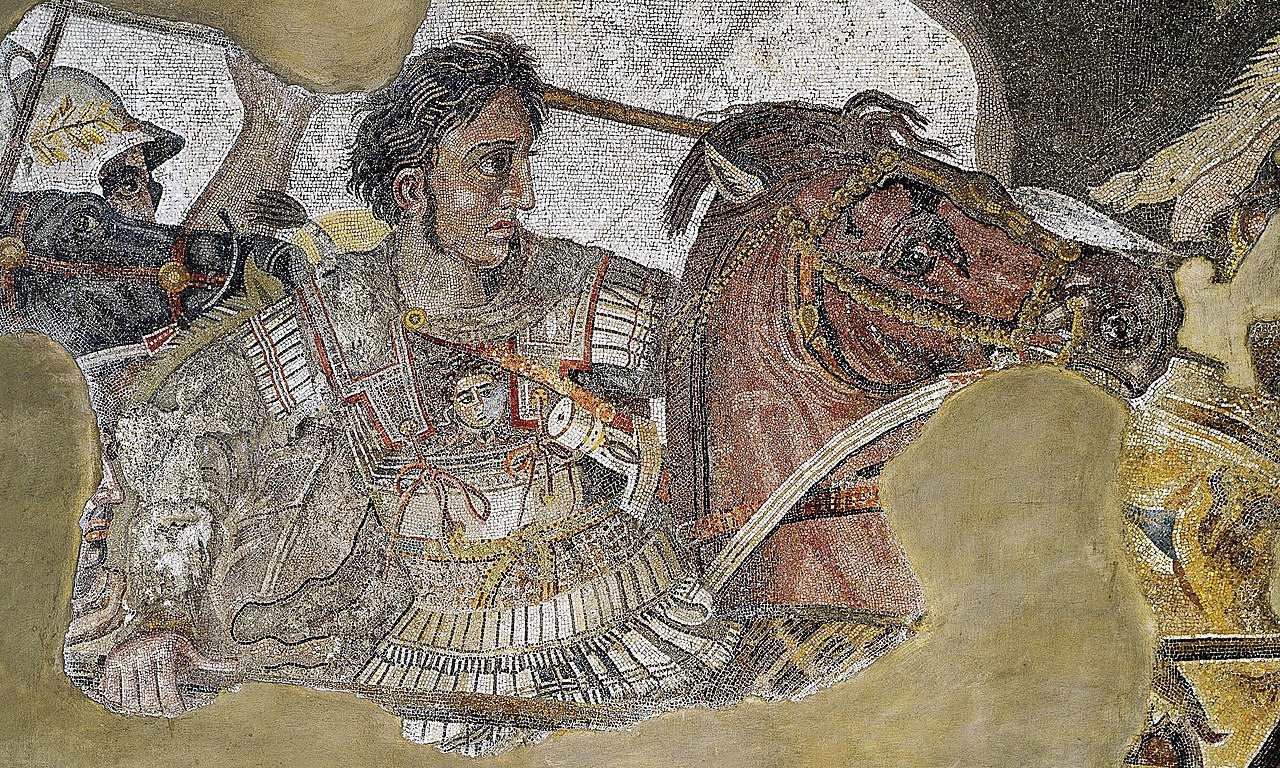ALEXANDER THE GREAT
(334-321/323 B.C.)
Alexander’s father, King Philip of Macedon, had gone a long way towards achie ving the union of all the provinces of mainland Greece and the islands, and at the time of his assassination he was making preparations for war against Asia Minor and the east. Alexander took up his father’s plans, and completing his military preparations he set forth on an expedition into Asia. The landing of the expedition on Asiatic shores (334 B.C.), and its subsequent advance across the mainland, were unopposed until the battle of Issus, where the Persian opposition under Darius III was routed. Alexander then set his triumphant forces to the reduction of Phoenicia and Syria, and in 332 B.C. he was able to occupy Egypt without serious resistance. This done, he marched through Der- ez-Zor on the Euphrates to the Upper Tigris region, and at Gaugamela near Erbil he was confronted by an enormous army which had been collected by Darius. There ensued a fierce battle, which resulted in the complete defeat of the Persians and the flight of Darius. The whole of Iraq now lay open before Alexander, and in 331 B.C. the conqueror made his triumphed entry into Babylon. He treated the long renowned city with res- pect, ordering the rebuilding of its great temple and other public buildings, and win- ning the confidence of the priesthood and people. After a short stay, Alexander then proceeded against Persia itself, and sacked the capital city of Persepolis, which he treated with great severity, burning down the magnificent palace of Darius. Thereafter, he launched out on his great march to the east, which took him through Central Asia into northern India. There he was forced to yield to the unrest among his troops, who complained of the endless campaigning into which he was leading them, and he decided to return to Susa. Once there, he began to put through schemes which he had formed for the removal of the barriers between east and west: he married a Persian wife himself,
and following his example 10,000 Macedonians are said to have taken Asiatic wives too. Later he made his headquarters at Babylon, and it was there, when he was preparing for an expedition into the desert against Arabia, that he fell ill and died (321 or 323 B.C.). Since he left no direct heirs to the throne, his empire fell into the hands of his generals, who, after internal strife, eventually decided on a division of the great territories among themselves. Mesopotamia and Iran were allotted to Seleucus, and he soon added Syria to his lands.
SELEUCID PERIOD (in Iraq 313/2-139 В.С.)
Seleucus I (Nicator, that is, The Victorious; 313/2-281 B.C.) a general of Alexander’s founded the Seleucid Dynasty, and built himself a new capital on the Tigris called Seleucia (Tell Umar, opposite Ctesiphon). He is also known to have built himself similar cities in Mesopotamia, Iran, and Syria, one of these being Antioch on the Orontes, which was named after his father. They were built on Hellenistic models, and served as centres for the propagation of Greek culture and way of life over the vast territories which he controlled. At this date lived the Babylonian priest Berossus, who wrote a famous account in Greek of the history and civilization of ancient Mesopotamia, called the Babyloniaca.
Little is recorded of the history of the remainder of the dynasty. The adoption of Seleucia as the provincial capital seriously affected the fortunes of Babylon, which was deserted by a large part of its population, while even Seleucia itself suffered a reces- sion in favour of Antioch, which was preferred as the seat of government, no doubt largely because of its proximity to Greece. The kings of the dynasty were eighteen in number, mainly called either Antiochus or Seleucus, one of the most successful being Antiochus III (223-187 B.C.), under whom Babylonian culture and astronomy had a revival. The other monarchs were mostly weak, and their energies were largely de- voted to their contest with the Ptolemaic dynasty in Egypt. As a result they lost their control over the eastern districts, except for Syria itself. Other opposition to them came from the Arab Nabataean state centred on Petra, which lay athwart the major trade routes from Arabia to the north, and from a new threat in the east. This was the rising power of the Parthians, feudal tribesmen who came from Iran and were renowned for horsemanship. Their power and influence increased gradually over the years until in 139 B.C. their king Mithridates I, having conquered the Iranian plateau, succeeded in driving the Seleucid ruler Antiochus VII out of Mesopotamia and occupying it himself. There- after the domains of the Seleucids were confined to Syria alone, and in 95 B.C. Antiochus IX was defeated by a Roman army which occupied part of Syria. The dynasty survived with a succession of weak kings who ruled a restricted area of north Syria until only 64 B.C., when they too fell an easy prey to the might of Rome.
Faraj Basmachi + Iraq Museum


